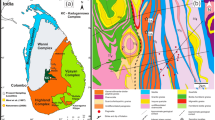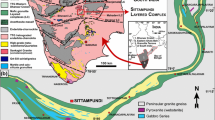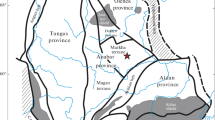Abstract
Silicate-oxide symplectites in complex mineral intergrowths are relatively common in upper mantle xenoliths and in xenoliths in the Jagersfontein Kimberlite, South Africa.Harzburgites of olivine and high-Al (1.9–3.6 wt%), Ca (0.6–0.9 wt%) and Cr (0.3–0.9 wt%) enstatite contain symplectites of spinel and diopside, or spinel, diopside and lower-Al (0.8–2.2 wt%), Ca (0.1–0.4 wt%) and Cr (0.02–0.8 wt%) enstatite. From textures and mineral chemistries these symplectites are interpreted to have formed by mineral unmixing and migration from Al−Ca−Cr discrete enstatite to adjoining mineral interfaces.Garnet harzburgites are composed of large (0.5–1 cm) olivine, equally large discrete low-Al (0.6–1.1 wt%), Ca (0.1–0.5 wt%), and Cr (0.1–0.3 wt%) enstatite and smaller interstitial garnet, diopside, and high-Cr and low-Al spinel. Symplectites are composed of either spinel+diopside+garnet, or garnet+spinel. Spinel diopside garnet symplectites have cores of spinel+diopside, resembling symplectites inharzburgites, but surrounded by rims of garnet or garnet+undigested globular spinel. From textures and chemistries we suggest that the spinel+diopside cores formed from Ca-Al-Cr-rich orthopyroxene initially as a nonstoichiometric homogeneous single phase clinopyroxene enriched in Fe, Cr and Al. This was followed by decomposition of the clinopyroxene to diopside+spinel, and subsequent garnet formation in a prograde reaction with olivine or enstatite. In bothharzburgites andgarnet harzburgites the metastable cellular structures may also have formed by the simultaneous precipitation of pyroxene and spinel. In all cases there is a strongly preferred embayment of symplectite bodies into olivine. Olivine appears to have activated adjacent
Similar content being viewed by others
References
Albee AL, Ray L (1970) Correction factors for electron probe microanalysis of silicates, carbonates, phosphates and sulfates. Anal Chem 42:1408–1414
Bai Q, Kohlstedt DL (1992) Substantial hydrogen solubility in olivine and implications for water storage in the mantle. Nature 357:672–674
Ballhaus C, Berry RF, Green DH (1990) Oxygen fugacity controls in the Earth's upper mantle. Nature 348:437–440
Barton M, Van Gaans C (1988) Formation of orthopyroxene-Fe-Ti oxide symplectite in Precambrian intrusives, Rogaland, Southwestern Norway. Am Mineral 73:1046–1059
Barton M, Sheets J, Lee WE, van Gaans C (1991) Occurrence of low-Ca clinopyroxene and the role of deformation in the formation of pyroxene-Fe-Ti oxide symplectites. Contrib Mineral Petrol 108:181–195
Basu AR, MacGregor ID (1975) Chromite spinels from ultramafic xenoliths. Geochim Cosmochim Acta 39:937–945
Bell DR, Rossman GR (1992) Water in Earth's mantle: the role of nominally anhydrous minerals. Science 25:1391–1397
Bell PM, Mao HK, Roedder E, Weiblen PW (1975) The problem of the origin of symplectites in olivine-bearing lunar rocks. Proc 6th Lunar Sci Conf Geochim Cosmochim Acta Suppl 6 vol 1:231–248
Bence AE, Albee AL (1968) Empirical correction factors for the electron microanalysis of silicates and oxides. J Geol 76:382–403
Boland JN, Otten MT (1985) Symplectitic augite: evidence for discontinuous precipitation as an exsolution mechanism in Ca-rich clinopyroxene. Metamorphic Geol 3:13–20
Boland JN, Van Roermund HLM (1982) Mechanisms of exsolution in omphacites from high temperature, Type B eclogites. In: Van Roermund, HLM (ed) On eclogites from the Seve Nappe, Jaemtland, Central Scandinavian Caledonides. Wiley, New York
Boyd FR (1971) Pargasite-spinel peridotite xenolith from the Wesselton Mine. Carnegie Inst Washington Ann Rep Director Geophys Lab 70:138–142
Bulatov V, Brey GP, Foley SF (1991) Origin of low-Ca, high-Cr garnets by recrystallization of low-pressure harzburgites. Extended Abstracts, Fifth Int Kimberlite Conf Brazil CPRM-Special Pub 2/91, pp 29–31
Canil D (1991) Experimental evidence for the exsolution of cratonic peridotite from high-temperature harzburgite. Earth Planet Sci Lett 106:64–72
Cox KG, Smith MR, Beswetherick S (1987) Textural studies of garnet lherzolites: evidence of exsolution origin from high-temperature harzburgites. In: Nixon PH (ed) Mantle xenoliths. Wiley, Chichester, pp 537–550
Dawson JB, Smith JV (1975) Chromite-silicate intergrowths in upper-mantle peridotites. Phys Chem Earth 9:339–350
Delaney JS, Smith JV, Carswell DA, Dawson JB (1980) Chemistry of micas from kimberlites and xenoliths-II primary and secondary textured micas from peridotite xenoliths. Geochim Cosmochim Acta 44:857–872
Exley RA, Smith JV, Hervig RL (1982) Cr-rich spinel and garnet in two peridotite xenoliths from the Frank Smith mine South Africa: significance of Al and Cr distribution between spinel and garnet. Mineral Mag 45:129–134
Field SW (1988) Metasomatism in upper mantle peridotite xenoliths from the Jagersfontein Kimberlite Diatreme, South Africa. PhD thesis, University of Massachusetts, Amherst
Field SW, Haggerty SE, Erlank AJ (1989) Subcontinental metasomatism in the region of Jagersfontein, South Africa. Geol Soc Australia Spec Pub 14, vol 2 771–783
Finnerty AA, Boyd FR (1984) Evaluation of thermobarometers for garnet lherzolites. Geochim Cosmochim Acta 48:15–27
Green HW, Burnley PC (1988) Pyroxene-spinel symplectites: origin by decomposition of garnet confirmed. EOS Trans Am Geophys Union 69:1514
Griffen WL, Heier KS (1973) Petrological implications of some corona structures. Lithos 6:315–335
Haggerty SE (1990) Redox state of the continental lithosphere. In: Menzies MA (ed) Oxford Mono on Geol and Geophys. Oxford Sci Pub, pp 87–109
Haggerty SE (1994) Superkimberlites: a geodynamic diamond window to the Earth's core. Earth Planet Sci Lett 122:57–69
Haggerty SE, Baker I (1967) The alteration of olivine in basaltic and associated lavas. Part I, high temperature alteration. Contrib Mineral Petrol 16:233–257
Haggerty SE, Sautter V (1990) Ultra-deep (>300 km) ultramafic, upper mantle xenoliths. Science 248:993–996
Harte B (1977) Rock nomenclature with particular relation to deformation and recrystallization textures in olivine-bcaring xenoliths. J Geol 85:279–288
Harte B, Gurney JJ (1983) Compositional and textural features of peridotite nodules from the Jagersfontein kimberlite pipe, South Africa. Terra Cognita 2:256–257
Hops JJ, Gurney JJ, Harte B, Winterburn P (1989) Megacrysts and high temperature nodules from the Jagersfontein Kimberlite pipe. Spec Publ Geol Soc Aust 14:759–770
Kohlstedt DL, Goetze C, Durham WB, Vander Sande (1976) New technique for decorating dislocations in olivine. Science 191:1045–1046
Krogh EJ (1988) The garnet-clinopyroxene Fe−Mg geothermometer—a reinterpretation of existing experimental data. Contrib Mineral Petrol 99:44–48
MacGregor ID (1980) The system MgO−Al2O3−SiO2: solubility of Al2O3 in enstatite for spinel and garnet peridotite compositions. Am Mineral 59:110–119
Mercier J-C, Nicolas A (1975) Textures and fabrics of upper mantle peridotites as illustrated by xenoliths from basalts. J Petrol 16:454–487
Michael E, Skinner W, Clement RC (1979) Mineralogical classification of Sourthern Africa kimberlites. In: Boyd FR, Meyer HOA (eds) Diatremes and diamonds: their geology petrology and geochemistry. American Geophysical Union, Washington DC 129–139
Moore RO, Gurney JJ (1985) Pyroxene solid solution in garnets included in diamonds. Nature 318:553–555
Mukhopadhyay B (1991) Garnet breakdown in some deep seated garnetiferous xenoliths from the central Sierra Nevada: petrologic and tectonic implications. Lithos 27:59–78
Perkins D III, Holland TJB, Newton RC (1981) The Al2O3 contents of enstatite in equilibrium with garnet in the system MgO−Al2O3−SiO2 at 15–40 Kbar and 900°–1600°C. Contrib Mineral Petrol 78:99–109
Sautter V, Haggerty S, Field S (1991) Ultra-deep (>300 km) ultramafic xenoliths: new petrologic evidence from the transition zone. Science 252:827–830
Schulze D (1989) Green garnets from South African kimberlites: their relationship to wehrlites and crustal uvarovites. Spec Publ Geol Soc Aust 14:820–826
Smith CB (1983) Pb, Sr, and Nd isotopic evidence for sources of southern African Cretaceous kimberlites. Nature 304:51–54
Smith D (1977) The origin and interpretation of spinel-pyroxene clusters in peridotite. J Geol 85:476–482
Solorzano IG, Purdy GR (1984) Interlamellar spacing in discontinuous precipitation. Metall Trans A, 15A:1055–1063
Vannucci R, Shimizu N, Piccardo GB, Ottolini L, Bottazzi P (1993) Distribution of trace elements during breakdown of mantle garnet: an example from Fabargad. Contrib Mineral Petrol 113:437–449
Winterburn PA, Harte B, Gurney JJ (1990) Peridotite xenoliths from the Jagersfontein kimberlite pipe. I. Primary and primary-metasomatic mineralogy. Geochim Cosmochim Acta 54:329–341
Wood BJ, Bryndzia LT, Johnson KE (1990) Mantle oxidation state and its relationship to tectonic environment and fluid speciation. Science 248:337–335
Yund RA, McCallister RH (1970) Kinetics and mechanisms of exsolution. Chem Geol 6:5–30
Author information
Authors and Affiliations
Rights and permissions
About this article
Cite this article
Field, S.W., Haggerty, S.E. Symplectites in upper mantle peridotites: Development and implications for the growth of subsolidus garnet, pyroxene and spinel. Contr. Mineral. and Petrol. 118, 138–156 (1994). https://doi.org/10.1007/BF01052865
Received:
Accepted:
Issue Date:
DOI: https://doi.org/10.1007/BF01052865




